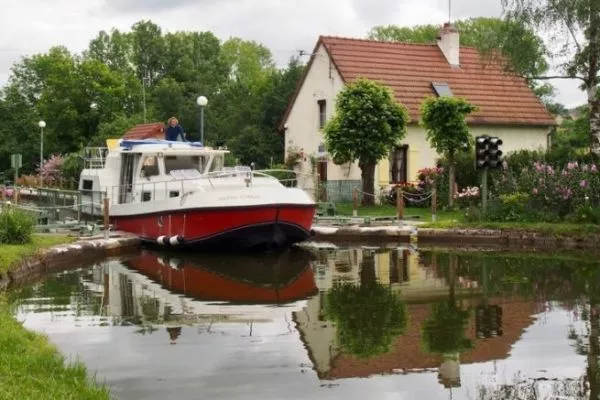The Functionality and Importance of Waterway Locks
Waterway locks play a critical role in facilitating the movement of vessels across varying elevations. This article delves into the principles and mechanisms that enable these essential structures to regulate waterway navigation effectively.
What Is a Waterway Lock?
A waterway lock is a system designed to raise or lower boats from one level to another. Built primarily on slopes, locks allow vessels to navigate across waterways with different elevations, whether it’s a weir-induced drop or the gradient of a canal. The concept of locks is not new; it dates back centuries, with one of the earliest designs attributed to the ingenuity of Leonardo da Vinci, who envisioned a lock with arched doors to withstand the pressure of water more effectively.
The Anatomy of a Lock
Locks consist of a masonry chamber, commonly referred to as a basin, which is flanked by two gates at both ends. These gates, known as mitre gates, close off the lock chamber, preventing water from spilling out and allowing it to fill or empty as needed. The gates are designed to harness the water pressure, effectively allowing for the safe transit of boats while maintaining adequate water levels.
Mechanisms That Control Water Levels
Each lock contains valves that facilitate the filling and emptying process. In smaller locks, the gates often feature manual hatches that can be operated by a lockkeeper. In contrast, larger locks may use hydraulic systems to manage water flow. The filling process typically involves backwater, which can be mitigated in larger installations by using bottom-filling valves to control water entry more effectively.
Balancing Water Levels for Safe Passage
For a boat to pass through a lock, the water level within the chamber must equal that of the side from which the vessel is approaching. Once the water levels are balanced, the gates can be safely opened. It is crucial that the levels on either side are allowed to stabilize before attempting to open the gates, as even minor discrepancies can exert substantial pressure on the gates, making transit difficult or dangerous. For example, in a standard lock of 40×5 meters, just a one-centimeter difference can result in a thrust of approximately two tons!
Navigating Through Locks: Upstream and Downstream
The Upstream Journey
When navigating through an ascending lock, boats typically enter with the chamber empty. They must act carefully to secure their mooring lines on the bollards located on the lockkeeper’s side. As the water fills the lock chamber, the pressure transitions from a powerful back current to a steady flow, allowing the boat to rise safely. Once the lock is filled and the water level equalized with the next section, the gates open, allowing the vessel to continue its journey.
The Downstream Experience
Navigating a downstream lock is generally more straightforward. Because the lock chamber is already filled with water, it simplifies the mooring line management. However, it is critical to avoid tying off the lines too securely to prevent the boat from becoming suspended during the emptying process. Like the ascent, the lockkeeper controls the fill levels throughout the journey downwards, making it smoother for the boat to leave once the water is lowered adequately.
Grouping Vessels for Water Conservation
In efforts to conserve water resources, it’s common practice to group vessels together when locking through. By coordinating this movement, the total water released during each transit can be significantly reduced. This is particularly beneficial during drought conditions. Boaters are encouraged to align their schedules, ensuring a comfortable passage while also helping save water and enhance efficiency.
Innovations and Variants in Lock Design
While traditional locks operate on the principles outlined, various regions have developed specialized designs catering to specific needs. For example, round locks in Midi, exceptionally large locks located along rivers, or unique vertical lifts where the chamber’s downstream door is operated by a guillotine mechanism all serve similar purposes but may cater to different navigational challenges and vessel types.
Technological Advances in Lock Mechanics
Technological advancements in hydraulic systems, including the mechanization of gate operations, have streamlined functionalities in modern locks. Automation reduces the human effort typically required to navigate through these critical structures, promoting safety and efficiency. Enhancements in lock design allow for better handling of larger vessels, which has evolved the standards for nautical navigation.
Conclusion: Linking Travel and Navigation
Waterway locks are pivotal to our navigation systems, providing essential links between areas separated by elevation. This natural progression in waterway management serves not just local transportation needs but bolsters broader economic activities by connecting regions through trade and leisure boating.
No matter the undertaking—be it fishing, leisure boating, or simply enjoying a seaside getaway—GetBoat.com stands ready to assist in your navigation journey. With options that cater to personal preferences, budgets, and itineraries, users can easily find a vessel that suits their needs, drawing on the spirit of freedom and adventure that the open water offers.
Experiencing new locations unfolds a tapestry of cultural and natural wonders, full of vibrant colors and rhythms unique to each destination. Embarking on your next seaside adventure should certainly include renting a boat, as every bay, lagoon, or windy harbor provides insights as profound as the local cuisine and architecture. Explore the captivating world of GetBoat.com and start your journey today, as every moment spent exploring uncharted waters is one to cherish.
Plan Your Adventure
The news concerning the advancements in waterway locks hints at a positive impact on global maritime navigation, although its immediate significance may vary. Enhancing slot accessibility, especially in tourist-heavy areas, aligns with GetBoat’s mission to stay updated on developments in the nautical world. As you plan your next coastal retreat, consider the diverse options available through GetBoat, ensuring you have a seamless and enjoyable experience on the water.


